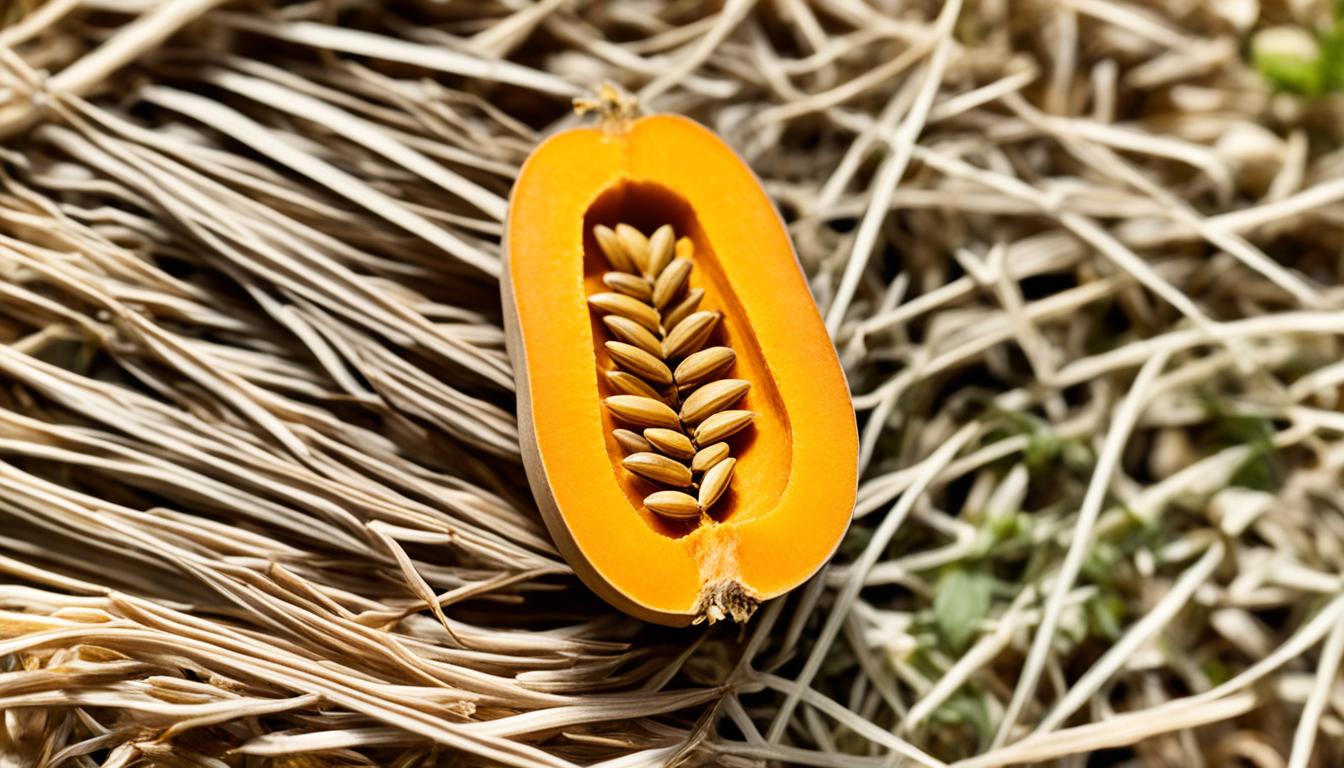Winter squashes, like butternut squash, are a big hit in gardens. These pear-shaped fruits are known for their sweet, orange flesh. They are ready to harvest in fall. Now is the best time to plant butternut squash seeds. We’ll talk about the perks of organic seeds and where to find them.
Key Takeaways:
- Organic butternut squash seeds are better for you and the planet. They don’t use harmful chemicals or pesticides.
- Using organic seeds means your butternut squash will be pure and natural.
- Look for butternut squash seeds at garden centers, nurseries, or online shops.
- Ensure you’re getting high-quality seeds by buying from trusted sources.
- It’s pretty easy to plant butternut squash seeds, and you should plant them in early April.
The Benefits of Organic Butternut Squash Seeds
Organic butternut squash seeds have many benefits for gardeners. They are free from harmful synthetic pesticides and chemicals. This makes them better for you and the planet. Also, these seeds are non-GMO, ensuring you grow a natural butternut squash.
Choosing organic seeds brings you benefits like:
- Healthier and safer: They grow without dangerous pesticides and chemicals. So, your butternut squash will be free from toxins.
- Environmental-friendly: Using organic seeds protects our planet. It prevents harmful chemicals from harming the ecosystem, improving soil health and biodiversity.
- Nutrient-rich produce: Organic farming boosts soil health with natural fertilizers. Therefore, butternut squash from these seeds has more vitamins, minerals, and antioxidants.
- Supports seed diversity: Small-scale farmers and seed savers produce these seeds. By choosing them, you help keep a variety of seeds alive.
“Growing butternut squash from organic seeds allows you to cultivate a premium crop that aligns with your values of health, sustainability, and supporting biodiversity.”
The importance of organic and non-GMO butternut squash seeds is huge. Choosing them means you’re gardening in a way that’s good for your health and the planet. Plus, you get the joy of eating delicious, homegrown butternut squash.
Where to Buy Butternut Squash Seeds
Several options are available if you’re looking to buy butternut squash seeds. You can find them at local garden centers or nurseries. Many online retailers provide a variety of butternut squash seeds, like organic and non-GMO types. Make sure to pick a trustworthy source for high-quality seeds.
Tips for Planting Butternut Squash Seeds
Planting butternut squash seeds can lead to lots of yummy squash. To grow them well, just follow these simple steps.
1. Starting Seeds
Start by planting the seeds in pots in early April. The pots should have good drainage. Put two to three seeds in each pot, an inch deep. Make sure to keep the soil moist, but not too wet.
2. Transplanting Seedlings
When the plants are a bit bigger and have a few sets of leaves, move them to bigger pots. This gives them more space to grow and develop strong roots. Be careful with the seedlings to not hurt their roots.
3. Planting Outdoors
After the last frost, usually in late May, you can plant the seedlings outside. Pick a spot where the sun shines bright and the soil drains well. Dig holes a bit bigger than the plants’ roots. Gently put the seedlings in the holes and cover them with soil. Then, press the soil around the plants lightly.
4. Hill Planting
It’s good to plant butternut squash in hills to help with draining and for more pollination. Make small soil mounds. Plant two to three seedlings on each mound, two feet apart. Be sure there’s enough room between the mounds for the plants to grow.
5. Providing Support
Butternut squash plants are pretty strong, but they do better with some support. This helps air move around them and keeps them from spreading too much. You can use things like trellises, stakes, or cages. This also makes picking the squash easier when they’re ready.
| Planting Tips Summary | Benefits |
|---|---|
| Start seeds in pots | Allows for controlled germination |
| Transplant seedlings | Promotes stronger root development |
| Choose a sunny location | Provides optimal sunlight for growth |
| Plant in hills | Improves drainage and pollination |
| Provide support | Prevents sprawling and aids in harvesting |
By taking these steps for planting butternut squash seeds, your plants will thrive. You’ll get a great harvest of tasty and healthy squash.
The Best Butternut Squash Seed Varieties
Choosing the right seed variety is key when growing butternut squash. Each variety brings something special to your garden. Here’s a look at some top butternut squash seeds:
1. Waltham Butternut
The Waltham Butternut is known for its smooth, vibrant orange flesh. It tastes rich and sweet, making it perfect for many dishes.
2. Hoss Butternut
For a high-yield, tasty squash, consider the Hoss Butternut. It gives you large, flavorful fruits for your cooking needs.
3. South Anna Butternut
The South Anna Butternut is ideal for small gardens. It’s a compact plant but still offers sweet, tasty squashes.
These are just a few options out there. Each variety offers unique flavors and growing traits. Try out different ones to find what works best for you.
With this info, you’re ready to start a butternut squash garden. Choose from varieties like the smooth Waltham, the high-yielding Hoss, or the compact South Anna. Each promises a plentiful harvest of this beloved autumn veggie.
Growing Butternut Squash Successfully
Want to grow butternut squash? Here are a few key tips. These will help you have a successful harvest. Essential advice for butternut squash seeds is below.
Keep the Plants Weed-Free
For the best growth, keep the plants free from weeds. Weeds take water, sunlight, and nutrients away from your squash. Check your garden often. Remove any weeds early on.
Provide Regular Watering
Butternut squash needs regular water to grow well. Aim for 1-2 inches of water every week. Check the soil’s moisture often, especially when it’s dry. But, don’t overwater. Too much water can cause diseases.
Feed the Hungry Plants
Butternut squash plants need lots of food. They need plenty of nutrients for growth and fruit. Use a balanced organic fertilizer weekly. This will help your plants grow strong and healthy.
Remove Leaves Covering Fruits
Remove leaves that cover the fruits. This improves air flow. It stops diseases and helps fruits ripen well. Sunlight will make them taste better and look great.
Lift Squashes Off the Ground
Lifting the squashes off the ground helps them ripen. It also stops rot. Put bricks or straw under them for better airflow. This keeps them dry and safe from pests or diseases.
Use these tips for growing butternut squash. You’ll enjoy a harvest full of tasty squashes!
Here’s a quick guide to these tips:
| Tip | Description |
|---|---|
| Keep the Plants Weed-Free | Regularly remove weeds to prevent competition for resources. |
| Provide Regular Watering | Water the plants consistently, aiming for 1-2 inches per week. |
| Feed the Hungry Plants | Apply a balanced organic fertilizer once a week for optimal nutrition. |
| Remove Leaves Covering Fruits | Expose the developing fruits by removing any leaves that cover them. |
| Lift Squashes Off the Ground | Elevate the growing squashes using bricks or straw to aid in ripening. |
Harvesting and Storing Butternut Squash
When your butternut squash fruits are ready, it’s harvesting time. Here’s the best way to harvest butternut squash and keep them fresh for a long time.
Harvesting Butternut Squash
Ready to pick butternut squash will have hard skin and a deep tan or beige color. Start with a sharp knife or pruning shears. Carefully cut the squashes from the vines, making sure to leave a bit of stem.
Tip: Keeping a small stem on the squash stops rot and makes them last longer.
Be gentle when handling the squashes to avoid damage. Make sure to pick them before the first frost hits. Frost can harm the squash.
Storing Butternut Squash
After picking, cure the squash to improve its shelf life. Curing means letting them sit in a warm, dry place for 10 to 14 days. This process strengthens the skin, making the squash keep longer.
After curing, store them in a cool, dry spot like a basement or pantry. Make sure there’s plenty of air flow to ward off mold. A good storage temperature is between 50°F and 60°F (10°C and 15.5°C).
Tip: Don’t store butternut squash near fruits or veggies that give off ethylene gas. It causes them to ripen and spoil faster.
With proper storage, butternut squash can last for three months. Always keep an eye out for any rot or damage. Remove bad fruits quickly to stop spoilage from spreading.
Common Problems and Solutions for Growing Butternut Squash
Growing butternut squash is rewarding but comes with challenges. Knowing common problems and their solutions is key for a good harvest.
Powdery Mildew on Butternut Squash
Powdery mildew is a big problem for butternut squash. It looks like white or grayish powder on leaves, stems, and fruits. It slows plant growth and lowers yield.
To stop powdery mildew, try these tips:
- Choose butternut squash varieties that resist diseases well.
- Plant your squash where there’s a lot of air and sunlight.
- Water plants at their base instead of from above to avoid mildew.
- Use a fungicide spray made for powdery mildew. Make sure to follow the spray’s instructions.
- Check your plants often for mildew signs. Remove any infected parts right away.
Pests and Diseases
Butternut squash can also get hit by pests and diseases. Cucumber mosaic virus, slugs, snails, and aphids are common issues.
Here’s how to fight these problems:
- Pick butternut squash types that are tough against pests and diseases.
- Always check your plants. Look out for signs of pests or disease, like damage or odd colors.
- Add good bugs, like ladybugs and lacewings, to eat bad pests.
- Choose natural ways to control pests, like picking off slugs or using organic repellents.
- Keep your garden clean. Remove dead plants that can attract or hide pests.
Taking early steps to prevent and manage issues can lead to thriving butternut squash plants and a great harvest.
Image:
Delicious Butternut Squash Recipes
Butternut squash is a versatile vegetable that you can cook in many tasty ways. Its sweet and nutty taste goes well with lots of ingredients. This makes it popular for both home cooks and chefs. You can make a warm soup, a filling main dish, or a delicious side with butternut squash. Try these great recipes featuring butternut squash:
Roasted Butternut Squash with Sage
Roasting butternut squash is a simple way to enjoy it. When roasted, the squash becomes sweet. Adding fresh sage gives it an earthy flavor. Here’s a recipe for this side dish:
- Preheat your oven to 400°F (200°C).
- Peel and remove the seeds from a medium-sized butternut squash.
- Cut the squash into 1-inch cubes and place them on a baking sheet.
- Drizzle the squash with olive oil and sprinkle with salt, pepper, and finely chopped fresh sage.
- Toss everything together until the squash is well-coated.
- Spread the squash evenly on the baking sheet and roast for about 25-30 minutes, until it’s golden brown and tender.
- Serve hot and enjoy!
Butternut Squash Risotto
For a creamy dish, try butternut squash risotto. The squash’s sweetness adds flavor to the rice. It creates a comforting meal. Here’s the recipe:
- Peel and cut a small butternut squash into small cubes.
- In a large pan, heat olive oil over medium heat.
- Add chopped onion and garlic and sauté until they’re clear.
- Add Arborio rice to the pan and cook for a few minutes, stirring.
- Pour in a splash of white wine and let it absorb.
- Add vegetable broth one ladle at a time, stirring constantly.
- After about 15 minutes, add the butternut squash cubes.
- Keep adding broth and stirring until the rice is creamy and just right.
- Season with salt, pepper, and grated Parmesan cheese.
- Serve hot and enjoy the creaminess!
Butternut Squash Pasta with Brown Butter Sauce
To indulge, make butternut squash pasta with brown butter sauce. The smooth sauce enhances the tender squash. It adds a buttery flavor to the pasta. Here’s the recipe:
- Cook your favorite pasta until al dente.
- In a large skillet, melt butter over medium heat until it’s golden brown.
- Add cubed butternut squash and cook until tender.
- Season with salt, pepper, and a pinch of nutmeg.
- Toss the cooked pasta in the skillet with the brown butter sauce.
- Garnish with Parmesan cheese and chopped fresh parsley.
- Serve immediately and enjoy this creamy, flavorful pasta.
“Butternut squash is a versatile vegetable perfect for many dishes. From simple roasted squash to creamy risotto and indulgent pasta, there’s a dish for every taste. Be creative and explore the delicious possibilities of butternut squash!”
Explore More Butternut Squash Recipes
Want more butternut squash recipes? Check Olive Magazine. They have lots of recipes with this flexible vegetable. You’ll find soups, salads, casseroles, and desserts. Visit their website for more butternut squash recipes.
Turn your kitchen into a place for culinary adventure with butternut squash dishes. Whether for a dinner party or a cozy meal, these recipes will impress. Embrace the variety of butternut squash and enjoy the amazing flavors!
Conclusion
Growing butternut squash from seeds is great fun. It lets you taste this vegetable’s flavorful and nutritious benefits. By picking top-quality seeds and choosing organic, you plant the best for a successful harvest.
To get a lot of butternut squash, water the plants right and feed them regularly. Keep pests and disease away. You can make many tasty dishes with this vegetable, like soups and roasted treats.
Why not start a butternut squash garden today? Plant your seeds and take care of your plants. Soon, you’ll enjoy the homegrown, sweet, orange squash. Embrace gardening’s joy and the flavor of your own harvest. Start now on this exciting garden journey with butternut squash!





